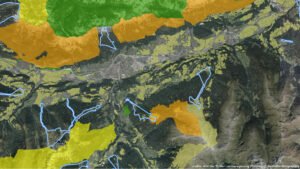ID53: Policy-relevant mountain biodiversity monitoring
Details
Full Title
Mountain biodiversity monitoring for effective policy making and management in the context of global change
Scheduled
Convener
Co-Conveners
Antoine Guisan, Emmanuel Reynard, Iago Otero, Helene Cristofari and Davnah Urbach
Assigned to Synthesis Workshop
1. Mountain Ecosystems under Global Change
Keywords
Environmental monitoring, adaptive monitoring, mountain social-ecological systems, interdisciplinarity
Description
Some of the most critical data for quantifying environmental changes in mountain social-ecological systems and identifying their causes, for understanding these systems and predicting their trajectories, and for informing environmental policies and agendas across scales are the time series provided by monitoring programs. However, to date we still lack the holistic and integrated framework needed to simultaneously observe the multiple dimensions of mountain social-ecosystems and the effects of the multiple factors driving their long-term change. In this session we propose to bring together an interdisciplinary group of mountain scientists to achieve an overview of existing and novel approaches to the integrated and adaptive monitoring of mountain regions across social and environmental sciences and discuss future avenues of how to (i) best delivers scientific and quantitative information about the state and trends of social-ecological mountain systems in the face of global change and (ii) best inform environmental policies.
Registered Abstracts
Abstract ID 535 | Date: 2022-09-14 10:00 – 10:10 | Type: Oral Presentation | Place: SOWI – Aula |
Tappeiner, Ulrike (1,2); Anderle, Matteo (1,2); Bottarin, Roberta (1); Guariento, Elia (1,2); Marsoner, Thomas (1); Paniccia, Chiara (1); Plunger, Julia (1); Rüdisser, Johannes (2); Scotti, Alberto (1); Seeber, Julia (1,2); Strobl, Julia (1); Hilpold, Andreas (1)
1: Institute for Alpine Environment, Eurac Research, Bolzano, Italy
2: Department of Ecology, University of Innsbruck, Innsbruck, Austria
Keywords: Integrated Monitoring, Global Change, Terrestrial, Aquatic, Social-Ecological Dialog
The need for long-term regional data on biodiversity population trends has grown rapidly in recent decades. This is particularly true for mountain regions, considered global hotspots for biodiversity. Local politicians, stakeholder organizations, and the public have a growing interest in sound and reliable data on biodiversity and ecosystem services. These data are needed to provide the scientific basis for political decisions, especially environmental policies and sustainable development.
In 2019, a permanent biodiversity monitoring program was initiated in South Tyrol, Italy, as an initiative of the local, provincial government, with experts from different fields responsible for data collection and scientific analysis, public involvement (e.g. Citizen Science), public and stakeholder information, and advice to policymakers.
Using consistent protocols, the Biodiversity Monitoring South Tyrol (BMS) aims to survey species groups sensitive to climatic and land-use changes across scales. The study sites are distributed evenly over the region. They include a representative selection of near-natural habitats, such as high-mountain grasslands, alpine brooks and forests, as well as habitats that have been strongly influenced by humans, such as meadows, vineyards, and residential areas. Since 2019, a total of 320 sites will be investigated for 5 years as part of the project's terrestrial monitoring. The surveyed taxa cover vascular plants, bryophytes, birds, bats, and insect groups, like grasshoppers and butterflies. For the aquatic part of the monitoring, a total of 120 individual areas of running water are being surveyed over a period of 4 years for water insect larvae. Hence, all 440 sites will be sampled in a 4- respectively 5-year frequency. In addition, data on abiotic factors, landscape structure, and site management are also being collected.
Another major focus of the initiative is the constant dialogue between the project experts and the local authorities. In addition, further research is regularly carried out within the framework of special projects. These typically relate to important questions on the impact of agricultural and forest management on biodiversity and ecosystem services as well as on current impacts of environmental changes such as extreme events or invasive species, including the analysis of mitigation or adaptation options or adaptive transformation pathways of the social-ecological system. Finally, communicating the results to the broad public is a crucial point of the BMS.
The presentation gives an overview of the project and reveals the findings of the project's first three years.
Abstract ID 612 | Date: 2022-09-14 10:10 – 10:20 | Type: Oral Presentation | Place: SOWI – Aula |
Dalton, Daniel T; Berger, Vanessa; Steinbauer, Klaus; Švara, Vid; Jungmeier, Michael
Carinthia University of Applied Sciences, Austria
Keywords: Biodiversity, Change Detection, Evidence-Based Decision-Making, Monitoring Guideline
We are facing a monumental biodiversity crisis where a human-caused sixth mass extinction is taking place. Mountain ecosystems are increasingly under threat from climate change, non-native species introductions, resource extraction, and other anthropogenic pressures. These ecosystems are classified by their prevailing climatic conditions and are characterized by perennially cold temperatures and winter snow cover. Mountain ecosystems are particularly vulnerable to global change because they are home to highly adapted species that are limited in their ability to cross biogeographic barriers for migration to new suitable environments. Thus, species and habitat monitoring are the key components that allow scientific evaluation of the state of mountain biodiversity and are the basis of adaptive management decisions.
Developing an effective biodiversity monitoring program in mountain protected areas involves a holistic approach considering environmental, social, and economic factors. We propose using the Monitoring Global Guideline (MoniGloG) as a unified framework for monitoring. This framework includes determining background site information, goals and legal obligations, as well as assessing key questions to systematically establish how monitoring should proceed. Critical to the framework is participation of diverse stakeholder groups. Support from indigenous groups and local residents allows for program acceptance. Integrating traditional knowledge, communities, and local actors will pinpoint areas of interest for local conservation.
To deliver scientific and quantitative information about the state of mountain ecosystems, and to best inform environmental policies, communication of findings to different end-user groups requires knowledge transfer in various formats. Outreach can involve direct engagement of visitors through citizen-science initiatives. To reach the scientific community and policy-makers, we advocate submitting data and reports in open-access repositories. Reporting in specific formats may be further required by regional or national protected area networks.
We present a comprehensive overview of the MoniGloG, including checklists for data acquisition, analysis, and storage, with a focus on communication of findings to the diverse stakeholders involved in mountain protected area management plans.
Abstract ID 610 | Date: 2022-09-14 10:20 – 10:30 | Type: Oral Presentation | Place: SOWI – Aula |
Schalk, Valentin; Sudmanns, Martin; Augustin, Hannah; Tiede, Dirk
University of Salzburg, Austria
Keywords: Mountain Green Cover Index, Earth Observation Data Cube, Semantic Analysis, Sustainable Development Goals
Mountain areas provide important ecosystem services like climate regulation, water treatment or hazard prevention. In this context, there is a direct correlation between the vegetation coverage of mountain areas and their ability to provide these services.
For this reason, the Food and Agriculture Organization (FAO) of the United Nations (UN) developed the MGCI to measure the extent of green coverage and related changes in mountain areas and is defined as the area ratio of all green plants in the mountain, including the area of forests, shrubs, woodlands, pastures, and farmland to the total area of mountains. The MGCI is an official indicator (15.4.2) for the UN's Sustainable Development Goal (SDG) 15 respectively the target 15.4, which is defined as follows: "By 2030 ensure the conservation of mountain ecosystems, including their biodiversity, to enhance their capacity to provide benefits which are essential for sustainable development" (United Nations, 2021)
The MGCI was established in 2016 and was first calculated based on a visual interpretation of global sample plots of satellite imagery with the Collect Earth tool developed by the FAO with support of Google Earth Outreach combined with the UNEP-WCMC mountain classification. There are several more recent calculation approaches, like FAO's new methodological approach from 2020, which is based on a quantitative analysis of standardized and yearly updated land cover maps (ESA CCI-LC), or Normalized Difference Vegetation Index (NDVI)-based MGCI calculations. There are also methodologies and approaches by single National Statistical Offices like in Germany. In Austria, there currently is no official nation-wide data for the MGCI available, but it is planned to be published in the future. However, sample-based methods can be time-consuming and error-prone. There is room for improvement to allow calculations on demand or to use the full spectral information provided from the sensors.
We present an approach for an Austrian-wide MGCI calculation based on semantic, sample-free remote sensing methods within a semantic Earth Observation (EO) data cube (Sen2Cube.at). Sen2Cube.at allows programming-free access to multidimensional semantically enriched EO data using semantic querying. In this context, we demonstrate a semantic query that combines multiple queries of satellite imagery (Sentinel-2) to detect vegetated mountain areas in certain time periods (e.g. a year or vegetation period) which can be compared afterwards. The semantic queries are stored in a knowledgebase and can be reused in the future on-demand. This allows a time and cost-efficient monitoring of the MGCI, especially useful for public authorities.
Abstract ID 541 | Date: 2022-09-14 10:30 – 10:40 | Type: Oral Presentation | Place: SOWI – Aula |
Alison, Jamie (1); Alexander, Jake (2); Dupont, Yoko (1); Iseli, Evelin (2); Mann, Hjalte (1); Høye, Toke (1)
1: Aarhus University, Denmark
2: ETH, Zurich
Keywords: Pollinator, Moth, Camera, Swiss Alps, Bumblebee
Recent decades have seen a surge in awareness about insect pollinator declines. While bees often enjoy the spotlight, most flower-visiting species – and around half of animal species – are non-bee insects. Despite this, non-bees are poorly represented in both science and media. Nocturnal flower visitors, e.g. moths, are especially difficult to observe and usually ignored. Within the few studies that do investigate nighttime pollinators, fair comparisons with daytime pollinators are almost never provided. Robust data are especially difficult to collect in montane areas, where access is difficult and terrain is hazardous.
Here we use remote time-lapse cameras for season-wide, day-and-night pollinator surveillance of an alpine grassland plant community. We reveal the first clear evidence that moths pollinate Trifolium pratense (L.; red clover), an important wildflower and forage crop species, contributing 34% of observed visits (bumblebees: 61%). This is a remarkable finding; moths have received no recognition throughout a century of T. pratense pollinator research in lowland agricultural systems. Our favored explanation for this is not that moth visits are negligible, but that nocturnal visitation has simply not been measured. Indeed, the most frequent nocturnal visitor to T. pratense was Noctua pronuba (L.; large yellow underwing/winter cutworm), a candidate for the most abundant macro-moth in Europe.
Crucially, we show how the relationship between visitation and seed set may only become clear after accounting for moth visits. It follows that trends in moths, as well as bees, could profoundly affect the reproduction of montane wildflowers. Above all, we show how camera surveillance permits data collection in montane ecosystems, while giving fair representation to non-bee pollinators. Furthermore, this approach builds a standardized image library – such libraries will be pivotal for automation of insect and flower identification in future.
Abstract ID 455 | Date: 2022-09-14 10:40 – 10:50 | Type: Oral Presentation | Place: SOWI – Aula |
Chauhan, Mona; Uniyal, V. P.
Wildlife Institute of India, India
Keywords: Forest Fire, Ecosystem Health, Policy Framework, Invertebrates, Monitoring
Repeated occurrences of forest fires have been affected the forest ecosystem and organisms significantly. Invertebrates, one of the most ecologically important taxa, have also been affected in several ways. Forest fire can affect individual fitness and population dynamics within a habitat by altered vegetation structure and composition, quantity and quality of coarse woody debris, and geophysical alterations. High temperatures, smoke, and oxygen depletion can cause mortality or impairment. To assess the impact of forest fire on biodiversity, long-term ecological monitoring is a prerequisite. Standardized protocols are urgently required, for better understanding of how different fire regimes influence the invertebrate abundance, diversity and species ranges. Considering all this, we have assessed the impact of forest fire on invertebrates, in western Himalaya. Western Himalaya is diverse in climatic features, particularly in temperature and precipitation associated with the alignment and altitudes of ranges, which determine the altitudinal growth and variety of floral and faunal diversity. Various forest types and urban habitat were classified into different forest fire regimes. We have categorized the sampling plots into high, medium and low forest regimes based on frequency of fire occurrence and hypothesized that community composition and species diversity would differ between these regimes. From this study, about 225 species of invertebrates falling into eleven orders have been identified that is Blattoida, Coleoptera, Dermaptera, Diptera, Hemiptera, Hymenoptera, Lepidoptera, Odonata, Orthoptera, Plecoptera and Araneae. Invertebrate diversity was highest in low fire regime while lowest in the high fire, may be due to absence of microhabitat and dense foliage, which provides nesting and breeding grounds for many insect species. In high regime sampling plots, where fire repeatedly occurs and severity is also maximum, less diversity was recorded. Diversity remains almost similar in low and medium regimes, which suggested that controlled fire burning is beneficial, suggested that it plays a vital role in the forest ecosystem dynamics and controlled burning can be useful land management tool. The results presented in this study will not only serve as a baseline for better understanding of existing taxonomic diversity but will also support future conservation and fire management programs. In conclusion, we suggest the use of long-term ecological monitoring and promotional/incentives in policy framework for the implementation of monitoring to facilitate the employment of long-term conservation strategies.
Abstract ID 754 | Date: 2022-09-14 10:50 – 11:00 | Type: Oral Presentation | Place: SOWI – Aula |
Töpper, Joachim Paul (1,4); Eide, Nina Elisabeth (1); Eide, Wenche (2); Framstad, Erik (1); Klanderud, Kari (3); Kolstad, Anders (1); Nybø, Signe (1); Vandvik, Vigdis (4,5)
1: Norwegian Institute for Nature Research, Norway
2: Swedish University of Agricultural Sciences, Species Information Centre, Uppsala Sweden
3: Norwegian University of Life Science, Faculty of Environmental Sciences and Natural Resource Management, Ås, Norway
4: University of Bergen, Department of Biological Sciences, Bergen, Norway
5: Bjerknes Centre for Climate Research, Bergen, Norway
Keywords: Ibeca, Ecological Condition, Mountain Ecosystems, Ecosystem Assessment, Ecological Indicator
Monitoring ecosystem condition is critical for informing sustainable nature and area management, and is an important element in ecosystem accounting. A sound assessment of ecological condition requires the integration of various data that cover the functional characteristics of the respective ecosystem. In 2021, we performed the first national assessment of ecological condition for mountain ecosystems in Norway applying the Index-Based Ecological Condition Assessment (IBECA) framework. IBECA follows an approach similar to the EU Water Framework Directive, aggregating indicators into an index separated into condition classes, and distinguishes the classes good and reduced ecological condition. The method is compatible with the UN framework for ecosystem accounting and can be applied at various spatial scales, all depending on the data available. Our assessment covered the national and regional spatial levels and thus had a substantial spatial extent as approximately a third of Norway's mainland surface represents mountain ecosystems. Our analysis is based on 19 indicators, spanning data on species, communities, remote sensing, and infrastructure, aggregated into indices for functional ecosystem characteristics, ecosystem pressures, and the overall ecological condition. The indicator data were required to i) be area-representative, ii) address some functional characteristic of an ecosystem, iii) be sensitive to one of the five major environmental pressures, and iv) be comparable to a quantifiable reference condition. Our results indicate good ecological condition for Norwegian mountain ecosystems with an index just above the threshold to reduced condition. Keystone organisms like small rodents and the mammal predators arctic fox and wolverine scored very low due to strongly reduced population levels. Also, the vegetation's signal on heat requirement was below the threshold, indicating a dominance shift in the vegetation in favour of warmer-loving species. In contrast, physical indicators of climate change, such as the spatial extent of glaciers, snow depth and snow cover scored above the threshold for reduced condition, but with large variability. Related to human land use, area without human infrastructure scored high, but mountain area connectivity was at the border to reduced condition. Our assessment indicates that the largest pressures on Norwegian mountain ecosystems to date relate to population management, followed by climate change and land use, the latter two still scoring just above the threshold for reduced ecological condition. Due to continued climate warming and development of cabins and roads we thus expect a negative future trend for these pressures and consequently for the overall ecological condition in Norwegian mountains.
Abstract ID 891 | Date: 2022-09-14 11:00 – 11:10 | Type: Oral Presentation | Place: SOWI – Aula |
Ramos, Blanca (1); Zamora, Regino (2,3); Pérez-Luque, Antonio Jesús (3); Granados, José Enrique (1); Navarro, Javier (1); Cano-Manuel, Javier (1); Barea, José Miguel (4); Aspizua, Rut (4)
1: Parque Nacional de Sierra Nevada, Spain
2: Department of Ecology, Faculty of Sciences, University of Granada
3: Laboratory of Ecology (iEcolab), Andalusian Institute for Earth System Research, University of Granada
4: Agencia de Medio Ambiente y Agua, Junta de Andalucía
Keywords: Adaptive Management, Ecosystem And Biodiversity Monitoring, In-Situ Datasets, Scientific Research Supporting Decision-Making
Sierra Nevada, located in South-Eastern Spain, is considered a biodiversity hotspot within one of the most important biodiversity hotspots of the world: the Mediterranean Basin. The analysis of the climate series available indicates that an increase of temperatures and a reduction of water and snow precipitation is already occurring, increasing the aridity of this mountain area. According to climatic models, this trend will continue in the coming years, similarly to what is also occurring in other mountain areas. This situation poses a threat for the survival of many native species, many of them endemic, and also of ecosystems and ecosystem services. It also represents new challenges for the formulation of new paradigms to cope with these changes by means of strategies and measures allowing their adaptation to changing climatic scenarios, while supporting their conservation and sustainable use. The Sierra Nevada protected area (National and Natural Parks) has created an infrastructure whereby scientists and managers work together to conduct decision-making for the management of its natural assets based on the most objective and reliable scientific knowledge: the Sierra Nevada Global Change Observatory. Five case-studies are presented under this communication, showing how the generation of in-situ datasets, their validation and scientific interpretation, have been applied to define and optimize the management practices: 1) Ibex management and the control of emergent diseases; 2) Recovery Plan of high-mountain juniper scrublands; 3) Post-fire ecological restoration plan; 4) Naturalization projects for Pine Reforestation grounds and development of decision-making tools and 5) LIFE ADAPTAMED, adaptive management for the protection of the Sierra Nevada ecosystem services in a changing scenario.
This work is part of Smart EcoMountains, the Thematic Center on Mountain Ecosystems of LifeWatch-ERIC.
Abstract ID 489 | Date: 2022-09-14 11:10 – 11:20 | Type: Oral Presentation | Place: SOWI – Aula |
Rüdisser, Johannes (1); Tasser, Erich (2); Tappeiner, Ulrike (1,2); Huemer, Peter (3)
1: University of Innsbruck, Austria
2: Eurac Research, Italy
3: Tiroler Landesmuseen Betriebsges.m.b.H., Austria
Keywords: Biodiversity, Insect Monitoring, Citizen Science, Lepidoptera, Sdg15
A remarkable decline of insect abundance and diversity is observed in many terrestrial habitats, even in protected areas. This is of special concern as insects are important components of ecosystems with influence on key ecosystem functions and related to the supply of important ecosystem services. Data on most insect populations and their development in mountain regions are still inadequate. Butterflies (Papilionoidea) are one of the best-investigated insect groups, with precious long-term observation data from numerous monitoring schemes, mostly executed by volunteers in different regions and countries. Site-based monitoring schemes that involve volunteers are, however, often biased towards good-quality and hence butterfly-rich habitats. Therefore, we present a butterfly monitoring approach – which has already been applied at 200 sites in Western Austrian – using a spatially representative sampling design. It aims to representatively monitor the development of butterfly populations on the landscape scale in order to provide scientific basis for evidence-based environmental politics and ample protection measures on national and international scale. For a cost-effective implementation, we propose the combination of structured citizen science observations with recurring expert assessments. Volunteers are engaged in the systematic butterfly surveys to complement the detailed surveys carried out by experts and hence increasing the temporal survey resolution while, at the same time, promoting public awareness and engagement for insect conservation in mountain regions. Citizen science aided biodiversity research and monitoring is a very fast developing and growing field. Its combination with established research approaches can promote mutual enrichment, provide educational opportunities, and support broad community based biodiversity observation efforts. We are convinced that the chosen approach can serve as a blueprint for many other similar monitoring needs.
Abstract ID 779 | Date: 2022-09-14 11:20 – 11:30 | Type: Oral Presentation | Place: SOWI – Aula |
De Haan, Stef (1); Ccanto, Raul (2); Otiniano, Ronal (3); Huanca, Catalina (4)
1: International Potato Center (CIP), Peru
2: Grupo Yanapai, Peru
3: Asociación Pataz, Peru
4: Universidad Pública de El Alto, Bolivia
Keywords: Crop Genetic Resources, Intraspecific Diversity, Policy
The crop genetic resources conservation community has long expressed concerns about landrace loss and genetic erosion. Yet hard evidence of loss of alleles, landraces or shifts in their frequencies is commonly lacking because of the non-existence of baseline or time series data, fixed monitoring sites, standardized methods or solid partnerships, among other prerequisites needed for the systematic monitoring of the conservation status of crop genetic diversity in centers of origin like the Andes.
The Andean Initiative coordinated by the International Potato Center – in close collaboration with diverse grassroot stakeholders – has gradually build a network of Andean observatories and developed multilevel baselines combining genetic, varietal, species and spatial metrics. These baselines are robust inventories allowing for timeline comparisons using a set of well-established protocols available in an open-access toolbox. The network currently covers hotpots in the northern and central Peru, and northwest Bolivia. While not yet covering the complete range of the Andean potato genepool, the initiative is currently one of very few cases for the systematic monitoring of on-farm agrobiodiversity.
In this talk we will present the framework and the methodologies developed for regional hotspot mapping and site identification, multilevel baseline development, red listing, locally owned documentation of associated traditional knowledge and information management. It builds on 10 years of evolving experience in the Andes. The framework can be expanded to other crops and regions. Baseline research will allow for time series comparison, genetic gap analysis and spatial distribution mapping. Importantly, results provide robust intelligence about the conservation status of landraces in their center of origin. A key outcome relates to the availability of adequate information to design policies and prioritize evidence-based interventions.



